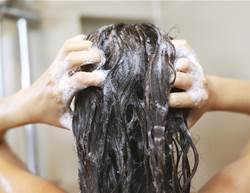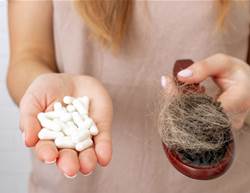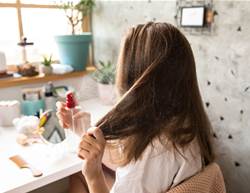If you rake a brush through your hair post-shower to find it surprisingly fuller than normal, it’s understandable to be alarmed. However, before jumping to conclusions, it’s important to understand hair shedding vs. hair loss, and how to handle each. Because, contrary to popular belief, they’re different experiences, yet they’re commonly confused for one another.
Below, experts explain which is which, how to tell the difference, how much hair loss is normal, and when to see a dermatologist about your concerns. Plus, how to handle hair shedding and hair loss at home.
What is hair shedding?
“Hair shedding is part of the hair’s natural cycle. It’s completely normal to shed about 50 to 100 hairs a day,” explains restorative hair surgeon Ross Kopelman. In fact, shedding is healthy, he says. Just like our skin regenerates and dead skin cells flake off, hair follicles go through a life cycle that includes growth, rest, and shedding, he adds.
Contrary to popular belief, normal hair shedding is not made worse by hair brushing or washing, says dermatologist Dr Morgan Rabach.
What is hair loss?
Hair loss is characterised by persistent shedding in high volumes, Kopelman explains, which may lead to noticeable hair thinning or bald patches. In these cases, the follicle, rather than going through a normal cycle, “becomes damaged or inactive and stops producing hair,” he says.
Clinically, this type of hair loss is referred to as alopecia, adds Dr Rabach, and can be caused by a variety of factors including genetics, chemotherapy, hormonal changes, autoimmune conditions or thyroid disease, normal ageing or environmental factors.
Hair shedding vs. hair loss
If the seasons are changing or you’re under a lot of stress, you might notice more shedding than usual, Dr Kopelman says, but the problem typically resolves itself. “The major difference between hair shedding and hair loss is that shedding is temporary and part of the growth cycle, while hair loss often leads to permanent thinning or balding if left untreated,” he concludes.
Because there are more than 100,000 hair follicles on a person’s scalp, Dr Rabach adds, dropping 100 or so strands a day doesn’t typically make a big difference in your hair’s appearance, whereas hair loss does.
How to combat hair loss at home
There are a few things you can do at home to reduce your risk of hair loss or worsened hair loss.
Eat a balanced diet
“Focus on foods rich in vitamins and minerals like biotin, zinc and iron,” says Dr Rabach. “Extreme diets without iron and vitamin B, as well as fasting diets may cause extreme hair loss.”
Scalp massage
Physical massage with a scalp massager or simply using your fingertips may promote blood circulation to the hair follicles and improve hair growth, says Dr Rabach.
Gentle hair care
Avoid styling methods that may cause irritation to the strands or scalp, Dr Rabach suggests, such as tight, overly heavy weaves or ponytails, or harsh treatments like perms or chemical straightening.
Manage stress
Stress and immune system function have been linked to alopecia, and conversely, managing stress may help recuperate hair loss, or at the very least, make coping with it easier. Dr Rabach says practices like yoga and meditation can help reduce stress-related hair loss.
Try supplements
“I also suggest supplements, such as biotin, that are formulated to strengthen hair from within,” says Dr Kopelman. However, speak to your doctor first as biotin, or vitamin B7 can result in the underdiagnosis of heart attacks, reports Jama Dermatology.
Many hair experts say that there's little high quality data proving that hair supplements work.
Try rosemary oil
“I often recommend rosemary oil as an at-home remedy because it has shown promise in helping some patients with thinning hair,” Kopelman adds. Research is preliminary, but rosemary oil is an increasingly popular and accessible at-home hair treatment used to encourage hair growth.
When to see a doctor about hair loss
“See your dermatologist if you’re noticing an increase in your shedding,” says dermatologist Dr Candace Thornton Spann. “Signs like gradual thinning on the top of your head, a widening part, the appearance of patchy or bald spots on your scalp, and a reduction in overall hair density are signs that there may be an underlying health condition. It is important to see your doctor as soon as possible as hair loss, like many things, is best treated early.”
Accompanying symptoms like itching, pain, or scaling on the scalp are also red flags to make an appointment, says Dr Rabach, especially if you have a family history of severe hair loss or underlying medical conditions.
Dietary supplements are products intended to supplement the diet. They are not medicines and are not intended to treat, diagnose, mitigate, prevent or cure diseases. Be cautious about taking dietary supplements if you are pregnant or breastfeeding.










